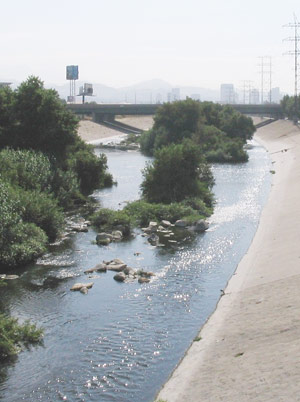Pacific Southwest, Region 9
Serving: Arizona, California, Hawaii, Nevada, Pacific Islands, Tribal Nations
EPA Takes Action to Strengthen Environmental and Public Health Protection for the L.A. River Basin

Related Information
- Special Case Letter and Evaluation (PDF) (38 pp, 14M, large file)
- Special Case Letter only (PDF) (1pg, 205K)
- Definition of "Waters of the United States"
LOS ANGELES - U.S. EPA Administrator Lisa P. Jackson today announced the Agency’s decision that will ensure more effective protection under the Clean Water Act (CWA) for the Los Angeles River and for those who use the river for boating, fishing, and other recreational and commercial opportunities. The announcement strengthens future environmental protection for the entire 51-mile river and for small streams and wetlands throughout the L.A. River Basin, affirming the Agency’s commitment to urban communities and natural resources. The decision reflects years of work by EPA, in coordination with Federal, State, and local partners and the public, to strengthen future protection for the river and surrounding watershed.
“This designation assures the community that their local waters are protected by the nation's water laws," said EPA Administrator Lisa P. Jackson. "A clean, vibrant L.A. River system can help revitalize struggling communities, promoting growth and jobs for residents of Los Angeles. We want the L.A. River to demonstrate how urban waterways across the country can serve as assets in building stronger neighborhoods, attracting new businesses and creating new jobs."
Today’s action clarifies the legal status of the L.A. River under the CWA and strengthens protection for the tributary streams and wetlands that make up the L.A. River watershed. EPA’s decision enhances the ability of the EPA, in coordination with the Army Corps of Engineers, the State, and the City, to fight pollution and protect the health and safety of those who use these waters. In particular, it will help federal, state and local agencies stop the future destruction of natural streams, wetlands, and other waters remaining in the L.A. Basin that are important for water quality, wildlife, recreation, and public health, and to reduce harm to the watershed from polluted stormwater runoff.
“I am pleased that the EPA has acted to protect the Los Angeles River,” said Rep. Henry A. Waxman, who represents California’s 30th Congressional District. “I have long fought for the river to be protected, and this action today will ensure that the river and the entire Los Angeles River Basin will retain their Clean Water Act protections. I hope this step will put our efforts to revitalize this important waterway back on track.”
Los Angeles Mayor Antonio R. Villaraigosa, Los Angeles County Supervisor Mark Ridley-Thomas and other local, state, and federal elected officials joined Jackson for the announcement at Compton Creek. In addition, students from Compton High School Agua University engaged officials with a demonstration on water quality testing.
Much of the Los Angeles River is accessible through interstate highways, surface streets, and parks and is home to a 49-mile formal and informal bicycle trail. The public regularly uses the river for recreational boating, fishing, educational activities, bird watching, artistic festivals, and other community activities.
The L.A. River begins at the confluence of Arroyo Calabasas and Bell Creek in the San Fernando Valley and flows to the Pacific Ocean at the San Pedro Bay. Today’s decision designates the Los Angeles River a “Traditional Navigable Water,” one of several categories of jurisdictional waters under the Clean Water Act. The designation is based on a myriad of factors including the river’s current and historical navigation by water craft, current commercial and recreation uses, and established local plans for restoration of the river.
The Clean Water Act protects the Nation’s rivers, streams, wetlands, lakes and other waters from pollution and other activities that destroy and degrade these vital natural resources. EPA is responsible for identifying waters protected under the Act and works with its federal, state, and local partners to protect public health and the environment. Assuring the ecological integrity of the Nation’s waters also enhances economic opportunities dependent on abundant, clean, and healthy aquatic resources.
| Region 9 NewsroomRegion 9 Programs | Grants & FundingUS-Mexico Border | Media CenterCareers | About Region 9A-Z Index |
